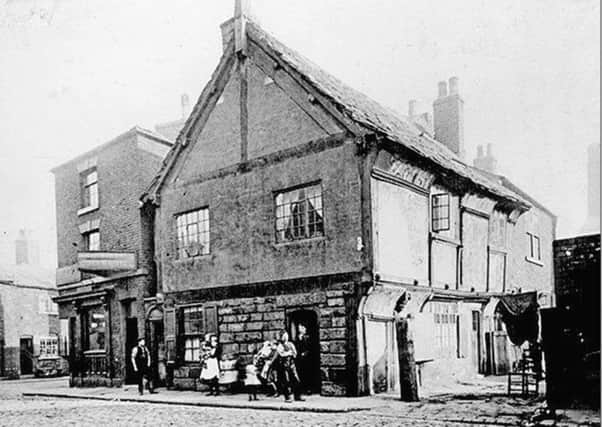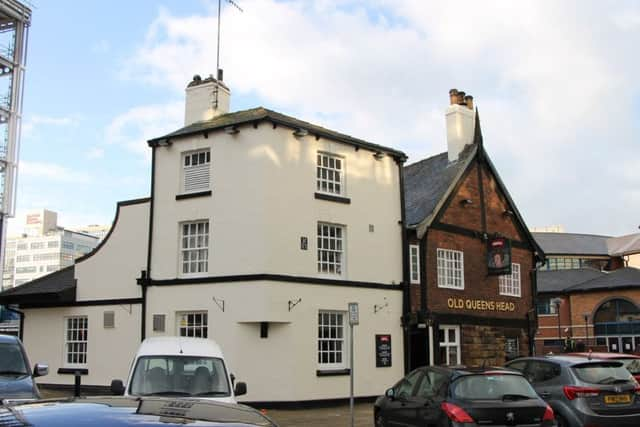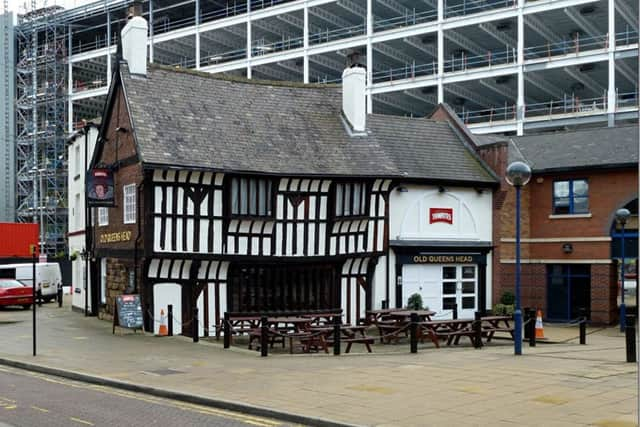Retro: Right royal tale behind city's oldest pub - or is it?


The city has grown around this lovely old building from a small hamlet on the banks of the River Sheaf under the protection of the Castle.
Sadly, the Queens Head Hotel is now cowering under the shadow of horrible buildings that have been thrown up around it – just what has it done wrong?


Advertisement
Hide AdAdvertisement
Hide AdIt is reputed to be the oldest domestic building in the city.
It was originally known as The Hawle In The Ponds and it was first mentioned by name in an inventory put together for George, the sixth Earl of Shrewsbury.
It was also said to have been the laundry for Sheffield Castle, plus it has connections to Mary Queen of Scots as it was recorded in 1820 as her wash house.
But these claims do raise doubts in my mind.


The original building was much larger than you see today – it was altered for road widening in the 1800s.
Advertisement
Hide AdAdvertisement
Hide AdIt is claimed that the old house became a pub in 1851 but looking at a photo that accompanies this article, you can see a group of people standing outside what was then a domestic dwelling and the Queens Hotel stands on the corner of River Street, now River Lane.
The people in the photo are not dressed in the clothes of 1851, which is the year it supposedly became a pub but I think it didn’t become a pub until 1890 after James Pilley moved into the old house, as the Old Queens Head was closed on River Lane in 1890 and incorporated into what we see today – so its logical that’s when the Queens Head came into being.
Its first landlord was James Pilley and he is listed in the directory of 1849 as living at 25 Paternoster Row and also listed as running a beerhouse at No 2 River Street.


He’s also listed as a nail and rivet maker at 2-4 River Street – the Queen Hotel that Mr Pilley ran can still be seen but its entrance door is now bricked up.
Advertisement
Hide AdAdvertisement
Hide AdI can’t say for sure when James called his beerhouse the Queen Hotel but when he moved into what we see now, he took to calling it the Queens Head Hotel.
It is just conjecture as to why it was named The Queens Head – was it after Mary Queen of Scots or was it after the carved head of a queen that still adorns the pub?
I prefer the latter.


In Douglas Lamb’s A Pub On Every Corner, he places the Queen Hotel on River Lane and its opening year 1890 but I think that’s the year it was closed and its licence transferred into what we see today.
The Queens Head Hotel is shown where it is today as being on the corner of Pond Hill and Creswick Walk, originally Creswicks Square, and its year of opening 1851, but there’s more people out there that have access to more accurate information than I have but I think I could be right solely on the clothes the people are wearing in the photo.
Advertisement
Hide AdAdvertisement
Hide AdThis area of the town was a hive of industry and the area was called Sheaf Island.
Names that have gone are Mates Square, Dyers Bridge, Sheaf Row and Vaughan’s Wheel.
Joseph Rogers & Sons produced first-class cutlery and pen and pocket knives here, Widow Oaks made scissors on River Street and at No 3 River Street in 1849 cowkeeper Saville Pacey carried out his trade.
By 1856 he must have died as his wife Ann Pacey had taken over the work and by 1862 the business had changed hands to Charles Smith.
Advertisement
Hide AdAdvertisement
Hide AdIn 1862, George Hoult is listed as a horse slaughterer at No 13 Pond Hill and at No 19 Thomas Middleton was landlord of the Horse & Jockey, also on Pond Hill, later re-named the Lyceum.
Charles Allcard made horn and bone buttons and he also dealt in horns and bones at the River Works.
Jumping to 1911 at No 22 Pond Hill, John Young slaughtered horses while at no 20 Mrs Emma Shephard ran her dining rooms.
Close by James Brindley was making hammers and Batty Langley JP had his timber yard next door.
Advertisement
Hide AdAdvertisement
Hide AdOver the years the firms either closed or relocated until gradually only the Lyceum pub on the opposite side and the Queens Head was left selling beer on Pond Hill.
Joseph Rogers’ old building was taken over as the council’s housing offices but this too was demolished as was the Lyceum, the latter for the GPO sorting office.
George Senior’s Ponds Forge drop hammers lulled me to sleep every night as a lad as their thump, thump, thump could be heard up on the Manor.
The River Sheaf and the Don which ran through quiet peaceful countryside are now running through an industrialised landscape.
Advertisement
Hide AdAdvertisement
Hide AdI suppose if Mary Queen of Scots returned she would probably lose her head in an almighty rant – I still can’t understand why the council allowed this fantastic old building to be hemmed in with towering structures. It is the proverbial fish out of water – surely some green space could have been left around it?
I came across the following on the internet: “By the beginning of the 19th century, the building was being used as a residence. In 1840 a pub called the Queen Hotel was opened in the neighbouring building, and sometime after 1862 the pub expanded into this building.
The building was given Grade II listed status in 1952.
The pub was refurbished in 1993, as part of the Tom Cobleigh chain.
This re-enforces my claim that it didn’t become a pub until much later than some claim.